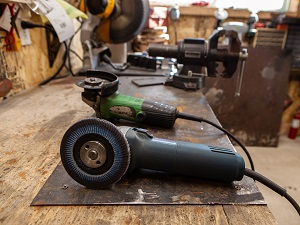When handheld portable grinders are used on the job they have a unique set of safety precautions that all workers should be aware of including preparation of a safe work area, PPE requirements and equipment selection and inspection.

Portable grinders are handheld power tools that are used for grinding, cutting or polishing. These versatile tools can be used for a variety of tasks and are commonly used on construction sites and in industrial shops.
Handheld portable grinders, with their own set of unique hazards, can be dangerous and can cause serious injuries or even start a fire causing property damage.
- Keep all tools in good condition with regular maintenance.
- Use the right tool and wheel for the job.
- Inspect the tool and wheel before work begins and do not use if damaged.
- Use the correct PPE for the task and always wear eye protection.
- Operate tools according to manufacturers’ instructions.
- Disconnect tools when not in use, before servicing or cleaning and when changing accessories.
When operating a power tool, like a portable grinder, many safety precautions happen before the work even starts.
- Inspect the work area to ensure there are no slip, trip and fall hazards and no flammable materials nearby.
- Other personnel should step away from the immediate work area.
- Secure the work with clamps or a vice so that both hands are free to operate the grinder.

Select the right tool and wheel for the job.
Do not grind or cut material for which the wheel is not designed. The wheel label should indicate the purpose or material. If the disc label is missing, do not use it. RPM indicates the maximum operating speed. Make sure the wheel you are using has an RPM rating that meets or exceeds the rating of the tool. The wheel should not be thicker or larger in diameter than what the grinder recommends. The arbor (the hole in the center of the wheel) needs to be the correct size for the tool.
OSHA General Industry Standard 1910.242(a) Each employer shall be responsible for the safe condition of tools and equipment used by employees, including tools and equipment which may be furnished by employees.
Inspect the portable grinder, the wheel that will be used, and the guard before operation.
Ensure the grinder is unplugged before inspecting, adjusting, removing or replacing parts. Inspect the tool for parts that may be broken, worn out, loose or missing. Look over the power cord to make sure it isn’t damaged and check to ensure the ground pin on the plug hasn’t been broken or removed. If the tool, cord or plug are found to be damaged or defective then tag and remove from service immediately. Check the wheel for cracks, chips, flaws, or deterioration and replace if necessary. Wet or damp wheels should be discarded.
OSHA Construction Standard 1926.300(a) All hand and power tools and similar equipment, whether furnished by the employer or the employee, shall be maintained in a safe condition.

OSHA requires that wheels be closely inspected visually and also ring-tested before mounting them on the portable grinder. This simple test checks for cracks or defects that might otherwise go unnoticed.
- Place the wheel on a non-metallic object like a wooden dowel or your finger.
- Lightly tap the wheel with a non-metallic object approximately 3/4” from the edge of the wheel and listen to the sound that is produced. A ting sound is what you want to hear to indicate the wheel is good.
- Rotate the wheel 1/4 turn and repeat the test for a total of 4 times per wheel.
- If you hear a thud sound during the ring test it means the wheel is defective and should not be used.
OSHA General Industry Standard 1910.243(c)(5)(i) Immediately before mounting, all wheels shall be closely inspected and sounded by the user (ring test) to make sure they have not been damaged in transit, storage, or otherwise.

OSHA Construction Standard 1926.303(c)(7) All abrasive wheels shall be closely inspected and ring-tested before mounting to ensure that they are free from cracks or defects.
Wear PPE that provides the best protection for the task.
Always wear approved safety glasses or goggles when using a portable grinder. Face protection is highly recommended to protect against flying debris. Don’t wear loose clothing or jewelry and make sure long hair is secured. Consider wearing hearing protection appropriate for the sound level and duration of the task. Gloves may be required if the task produces sharp particles or the materials become hot. A dust mask, work apron, or metatarsal foot protection may be needed based on the specific task.
OSHA General Industry Standard 1910.133(a)(1) The employer shall ensure that each affected employee uses appropriate eye or face protection when exposed to eye or face hazards from flying particles.
OSHA Construction Standard 1926.303(c)(9) All employees using abrasive wheels shall be protected by eye protection equipment.

.jpg)



